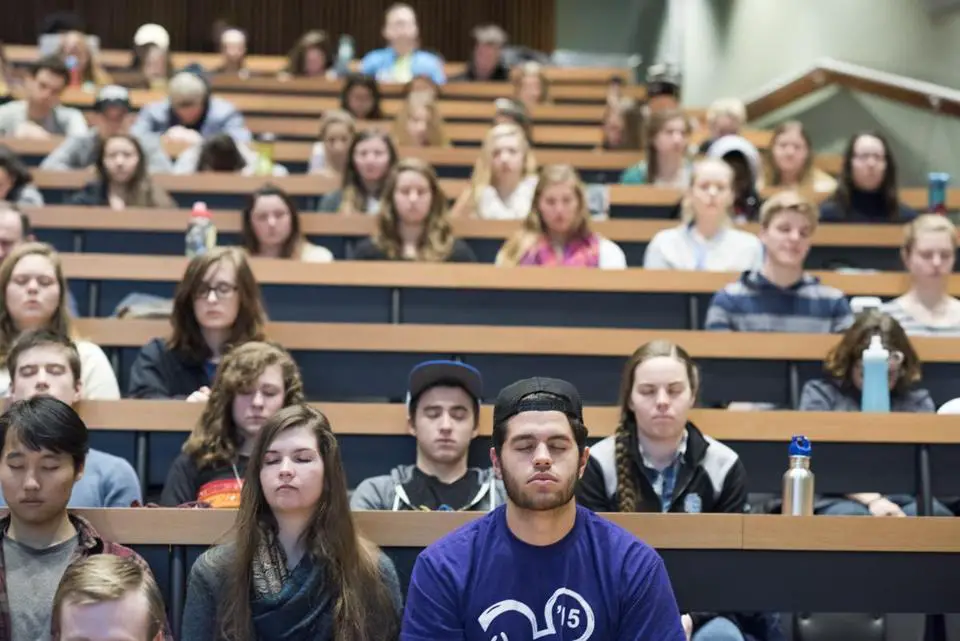If you’re like a lot of people, you might have tried out meditation one day full of hope that you’d become a Zen master of tranquility, and then promptly given up after realizing that meditation is, well, really hard.
I’ve been through this plenty of times — with meditation and also high school trigonometry, eating salad, waking up early to work out, etc. But unlike math and consuming leaves for dinner, meditation is not a useless endeavor with an unattainable end goal.
It’s not as difficult as you think! In fact, I think everyone can and maybe even should practice meditation once in a while. Even if you’re a busy and stressed out college student, there are ways you can integrate mindfulness into your daily life.
Yoga
Much of meditation is about focusing on the state of the mind and body. One of the first steps is bringing the attention away from external stimuli and to the breath.
 Yoga shares these principles. I would argue that if you’ve ever taken a yoga class or practiced at home, you have meditated. Don’t think that yoga lacks legitimacy because it’s been taken over by kale smoothie-drinking soccer moms—they’re on to something!
Yoga shares these principles. I would argue that if you’ve ever taken a yoga class or practiced at home, you have meditated. Don’t think that yoga lacks legitimacy because it’s been taken over by kale smoothie-drinking soccer moms—they’re on to something!
Having a physical task to do can help keep your mind from wandering and fixed on your body and mind. Thus, yoga can be a good introduction to meditation for those to whom it seems daunting. Also, if you’re interested in the spiritual aspects of practicing mindfulness, yoga and meditation share similar connections to Eastern philosophies. Yoga is super popular and you can find classes anywhere — your school might even offer them for free.
Guided Meditation
This is another good introduction to meditation when diving in headfirst can seem like too much. There are many forms guided meditation can take, the most accessible of which are apps. Headspace is one that’s been getting a lot of hype lately. It has short “courses” of different lengths that teach you the steps to meditation. Another one is called Stop, Breathe, and Think. It encourages users to check in with themselves and regularly assess how they feel, and it has a feature that tracks progress over time.
Finally, my favorite recommendation is for Jinglow, an app that helps you relax, meditate and deal with all kinds of stress. You can listen to hundreds of guided meditations, white noise, calming and ambient sounds, and much more. You can do body scans, you can even record and mix your own audio. All for free. It’s much more than a white noise app, but it does everything a perfect white noise app should do.
It might seem counterintuitive to use technology and look at a screen when trying to do something that should feel wholesome and freeing, but I’ve found using my phone in this way doesn’t make me feel reliant and like I’m wasting my life away like Twitter and Instagram do. (Don’t think, of course, that feeling my soul decay from social media keeps me from using it for hours every day!!)
There are also podcasts and YouTube videos of guided meditations for any need or occasion. I like to listen to Alan Watts—a renowned philosopher known for popularizing Eastern philosophy in the West and for his animated style of lecturing. It might not really count as true guided meditation but can almost produce the same effect, and is also pretty informative.
Mindful Eating
This is a way that anyone can easily add mindfulness to their day and quickly reap the benefits. Mindful eating means paying attention not only to what you eat, but paying attention while you eat. Lots of us eat while watching TV or doing homework or even talking to friends, and these are all distractions that pull our focus away from the present moment.
Obviously there are lots of great aspects to being able to talk to others over good food. But focusing only on your food every once in a while can be surprisingly enjoyable.
I once attended a Buddhist retreat where every meal served was eaten in a room full of people, but in complete silence. It feels strange, but it really does make you think about the connections among your mind, your body, and what you put into it every day.
Before Bed
A frequently touted benefit of mindfulness meditation is that it can improve sleep. Before you’re going to bed is a great time to meditate because it’s relaxing and soothing, and also because it’s a time when you’re usually alone with your thoughts anyways.
When it’s just you without any guidance or activity, a good way to try meditating is counting one through ten in your head with every breath you take. You can even say (in your head) in, one, out, two, in, three, etc. When you get to ten, restart the count.
While doing this, you should be focusing only on your internal state of being—the physical sensation of the breath and your mental voice counting. Your mind will wander and other thoughts will come into your awareness. Don’t worry or think you’re not “doing it right” when that happens—this is the pitfall that makes people think meditation is too hard for them! Really, it’s a perfectly fine part of the process and will lessen with practice.
When other thoughts come in, don’t get caught up in them or try to push them away. Just acknowledge they’re there and let them pass through. Watching thoughts pass through without making any judgment on them during meditation is commonly compared to watching clouds go by in an empty sky.
Meditation is supposed to be a restful activity—there is some evidence that it can even decrease the need for sleep— and the repetition of this might make you tired. That’s part of why this works well before bed, so go to sleep!
If the counting to ten method is more stressful than it is relaxing, try converging your thoughts elsewhere. Repeat a phrase over in your mind, or try to remember all the words to a favorite poem or song. The idea is to put all your effort and attention to your inner wellbeing and the present moment, and to let every other stray and irrelevant thought go.
The most important thing to remember is that as soon as you start trying, you’re already meditating. Most people have trouble clearing their minds 100 percent, and you’re not going to turn into Buddha overnight. But you will still see benefits from being mindful and you might even enjoy practicing.


















[…] of the best articles where you can find tips and tricks on Meditations hacks was written by students for students and an interesting opinion that I found was the importance of […]
[…] college kids preferring extra solitary meditation experiences, YouTube has a limitless provide of meditation movies and calming music to play throughout […]
[…] students who prefer more solitary meditation experiences, YouTube has a limitless supply of meditation videos and calming music to play during meditation. […]